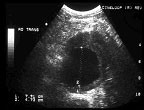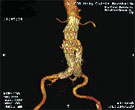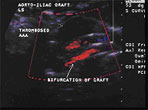AIMS:
These tests measure aortic size, especially diameters, to look for a developing aortic aneurysm, or carefully follow the size and location of a known aneurysm. Also, following EVAR (endovascular aneurysm repair), and sometimes open aneurysm repair, regular surveillance scans are performed using this non-invasive ultrasound technique
PATIENT PREPARATION:
For morning scan appointments, fast from midnight the night before the examination (no food, fluid, no smoking, no chewing gum). For afternoon appointments, fast for 8 hours prior to your scan time. Diabetics using insulin should not fast. Diabetics not using insulin should notify us when booking the test, and we will endeavour to make your appointment early in the morning. If this is possible, we would like you to fast as above. All patients should take their usual oral medications with a small amount of water.
TECHNIQUE & TEST DURATION:
The test takes about 45 – 60 minutes. The skin over the abdomen is coated with a small amount of clear jelly and an ultrasound probe is pushed against the skin. This produces a picture of the aorta and also measures blood flow in the aorta and its major branches. Accurate measurements are made of the size, shape and location of the aneurysm and/or the aortic graft. Sometimes, we will scan the arteries behind the knees to check for aneurysms that can occur there also.
DIAGNOSTIC CRITERIA:
Maximum diameter of the aorta is the most important measurement in diagnosing an aortic aneurysm. In general, aortic diameters of 2 cm or less are considered normal, 2 – 3 cm as “ectasia” or a possible very early aneurysm, and more than 3 cm as an aneurysm. The features examined when checking an EVAR or aortic graft repair include aortic size, evidence of graft kinking, leak or blockage, and blood flow in aortic branches.
Click here to view the worksheet.



